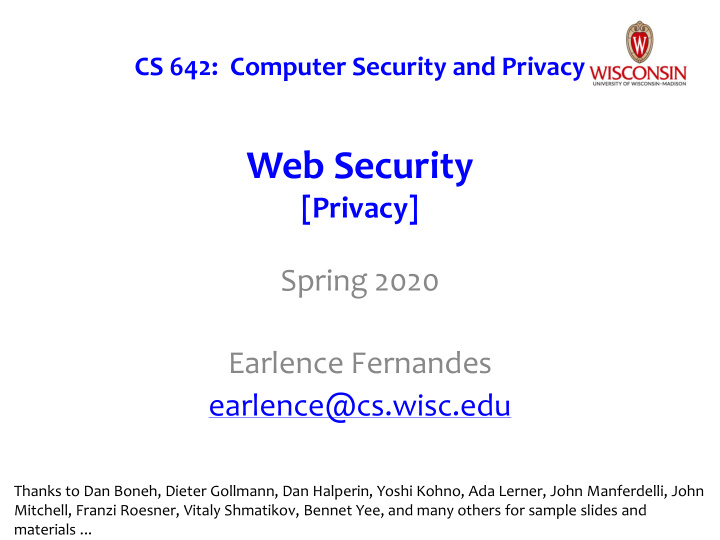



CS 642: Computer Security and Privacy Web Security [Privacy] Spring 2020 Earlence Fernandes earlence@cs.wisc.edu Thanks to Dan Boneh, Dieter Gollmann, Dan Halperin, Yoshi Kohno, Ada Lerner, John Manferdelli, John Mitchell, Franzi Roesner, Vitaly Shmatikov, Bennet Yee, and many others for sample slides and materials ...
Ads That Follow You Advertisers (and others) track your browsing behaviors for the purposes of targeted ads, website analytics, and personalized content.
Third-Party Web Tracking Browsing profile ile for or use ser 12 123: 3: cnn.com theonion.com political-site.com These ads allow crit riteo.c .com to link your visits between sites, even if you never click on the ads.
Concerns About Privacy
Outline 1. Understanding web tracking 2. Measuring web tracking 3. Defenses
Recall: First and Third Parties • First-party cookie: belongs to top-level domain. • Third-party cookie: belongs to domain of embedded content (such as image, iframe). www.bar.com’s Bar’s Server st part (1 st coo ookie (1 party) www.bar.com www.foo.com’s www.foo.com Foo’s Server rd part coo ookie (3 (3 rd party)
Anonymous Tracking Trackers included in other sites use third-party cookies containing unique identifiers to create browsing profiles. cookie: id=789 cr criteo.com use user 789 789: theonion.com, cnn.com, political- site.com, … cookie: id=789
Basic Tracking Mechanisms • Tracking requires: (1) re-identifying a user. (2) communicating id + visited site back to tracker.
Tracking Technologies • HTTP Cookies • Flash cookies • HTTP Auth • Silverlight storage • HTTP Etags • TLS session ID & resume • Content cache • Browsing history • IE userData • window.name • HTML5 protocol and • HTTP STS content handlers • DNS cache • HTML5 storage • “Zombie” cookies that respawn (http://samy.pl/evercookie)
Fingerprinting Web Browsers • User agent • Installed fonts • HTTP ACCEPT headers • Cookies enabled? • Browser plug-ins • Browser add-ons • MIME support • Screen resolution • Clock skew • HTML5 canvas (differences in graphics SW/HW!)
Your browser fingerprint appears to be unique among the 3,435,834 tested so far
History Sniffing How can a webpage figure out which sites you visited previously? • Color of links – CSS :visited property – getComputedStyle() • Cached Web content timing • DNS timing
Other Trackers? “Personal” Trackers
Personal Tracking cookie: id=earlence cookie: id=earlence face acebook.com use user fr franzi. i.roesner: : theonion.com, cnn.com, political- site.com, … cookie: id=earlence • Tracking is not anonymous (linked to accounts). • Users directly visit tracker’s site → evades some defenses.
Outline 1. Understanding web tracking 2. Measuring web tracking 3. Defenses
[NSDI ‘12] Measurement Study • Questions: – How prevalent is tracking (of different types)? – How much of a user’s browsing history is captured? – How effective are defenses? • Approach: Build tool to automatically crawl web, detect and categorize trackers based on our taxonomy. Longitudinal studies since then: tracking has increased and become more complex.
How prevalent is tracking? (2011) 524 unique trackers on Alexa top 500 websites (homepages + 4 links) 457 domains (91%) embed at least one tracker. (97% of those include at least one cross-site tracker.) 50% of domains embed between 4 and 5 trackers. One domain includes 43 trackers.
Who/what are the top trackers? (2011)
How are users affected? • Question: How much of a real user’s browsing history can top trackers capture? • Measurement challenges: - Privacy concerns. - Users may not browse realistically while monitored. • Insight: AOL search logs (released in 2006) represent real user behaviors.
How are users affected? • Idea: Use AOL search logs to create 30 hypothetical browsing histories. - 300 unique queries per user → top search hits. • Trackers can capture a large fraction: - Doubleclick: Avg 39% (Max 66%) - Facebook: Avg 23% (Max 45%) - Google: Avg 21% (Max 61%)
How are users affected? • Idea: Use AOL search logs to create hypothetical browsing histories. - 300 unique queries per user → top search See also: ADINT (2017) hits. • Trackers can capture a large fraction: - Doubleclick: Avg 39% (Max 66%) - Facebook: Avg 23% (Max 45%) - Google: Avg 21% (Max 61%)
How has this changed over time? • The web has existed for a while now … - What about tracking before 2011? - What about tracking before 2009? • Solution: time travel! [USENIX Security ’16]
The Wayback Machine to the Rescue Time travel for web tracking: http://trackingexcavator.cs.washington.edu
1996-2016: More & More Tracking • More trackers of more types
1996-2016: More & More Tracking • More trackers of more types, more per site
1996-2016: More & More Tracking • More trackers of more types, more per site, more coverage
Outline 1. Understanding web tracking 2. Measuring web tracking 3. Defenses
Defenses to Reduce Tracking • Do Not Track proposal? Do Not Track is not a technical defense: trackers must honor the request.
Defenses to Reduce Tracking • Do Not Track proposal? • Private browsing mode? Private browsing mode protects against local, not network, attackers.
Defenses to Reduce Tracking • Do Not Track proposal? • Private browsing mode? • Third-party cookie blocking? Bar’s Server www.bar.com’s st part (1 st coo ookie (1 party) www.bar.com www.foo.com’s www.foo.com Foo’s Server rd part (3 rd coo ookie (3 party)
Quirks of 3 rd Party Cookie Blocking In some browsers, this option means third-party cookies cannot be set, but they CAN be sent. So if a third-party cookie is somehow set, it can be used. How to get a cookie set? One way: be a first party. etc.
Defenses to Reduce Tracking • Do Not Track header? • Private browsing mode? • Third-party cookie blocking? • Browser add-ons? “uses algorithmic methods to decide what is and isn't tracking” Often rely on blacklists, which may be incomplete.
Recommend
More recommend